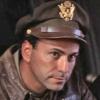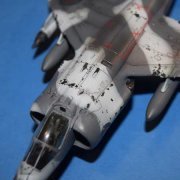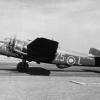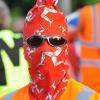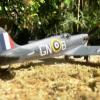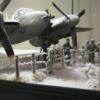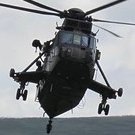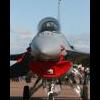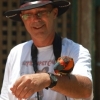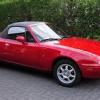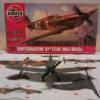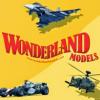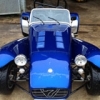Search the Community
Showing results for tags 'Mosquito'.
-
Hello fellow modellers, I would like to share my latest build with you. Since the Mosquito is a British plane, I think here is where 'she' belongs... Mosquito B Mk. IV Series II (Film Production Unit - FPU 1944) Serial No. DZ414, Callsign 'O' Orange with 'camera' mission markings... DZ414 was handpicked out at Hatfield Aerodrome (The De Havilland Factory) on 22. December 1942 by Flt Lt C.E.S. Patterson for service with the FPU ( RAF Film Production Unit). He subsequently flew DZ414 for 20.000 of its 24.000 miles, including its debut operation to L’Orient on 14. February 1943 in the wake of the 466-bomber raid staged the night before, the night bombing attack on Berlin on 20/21 April 1943 (performed to coincide with Hitler’s birthday), when DZ414 was badly damaged by flak, the raids on Turin and Nürnburg, and on the long-range operation to Jena on 27. May. The second ‘B’ on the nose is for the Berlin operation on 13/14 May 1943. Whilst part of the 2nd TAF, DZ414 took part in many notable operations, including 14 anti-Diver sorties (V-1 Flying Bombs) flown by Flt Lt Vic Hester of No 613 Sqn. along with cameraman, Flg Off Oakley, between 19-25. June 1944. The aircraft also participated in the Amiens prison raid on 18 February 1944, its pilot Flt Lt Tony Wickham, making three passes over the burning prison so as to allow Plt Off Leigh Howard to film the flight of 255 of the 700 prisoners released through the breached walls. On 31. of October DZ414 participated in the attack on the Gestapo headquarters in Aarhus, Denmark, filming the attack on the buildings of Aarhus University. Finally, on 21. March 1945 DZ414 was flown by Fit Lt K L Greenwood of No 487 Sqn. RNZAF, as part of the force sent on the Shellhouse raid, Flg Off E Moore of the FPU filming the first wave attack on the building. Despite its wartime contribution, this veteran machine was SoC in October 1946 and unceremoniously scrapped. The kit is HK Models 1/32 Mosquito B Mk. IV Series II. Aftermarket photoetch parts from Eduard & Profimodeller + a lot of scratchbuilding. HGW seatbelts. The RAF Accumulator Trolley is a resin kit from Iconicair with a scratch built JAP Engine Generator on top. None of the kit glass was used, instead the vac-formed canopy/nose glass from Tasman was used. And finally, some detail photos of the build... The cockpit, a mix of Eduard and Profimodeller photoetch together wit a lot of scratch built details... Rolls-Royce engine with cooper and lead wire/piping, scratchbuild exhaust shrouds, header tank, air compressor etc... Bomb bay interior with 'scratched' bomb attachment crates... Paintwork is done with AK Interactive RAF Daylight Fighters set, Ammo of MIG British Cockpit Colors, washes and oil weathering... Kit decals were used together with stencils from Profimodeller and some homemade markings printed on decal paper. Thanks for watching! Regards: Kent
- 49 replies
-
- 80
-

-
- 1/32
- De Havilland
-
(and 1 more)
Tagged with:
-
Hey guys, So a while ago I noticed that Airfix hasn't got a new tooling of a Mosquito in 1/72nd scale (I'm sure they're working on it) I thought this was a pity so I wanted to use their old tooling (more than twice as old as I am), then scratch build a half way decent interior and kit bash some aftermarket into it. I used a bomb bay set from CMK meant for the Tamiya Mosquito, a CMK Merlin engine meant for a Hasegawa kit, an Airwaves photo etch fret that is horrendously inaccurate but it has a pretty nice dashboard, and a set of resin wheels from Squadron. In addition to that I plan to scratch build the wheel wells, the landing gear, the cock pit and the nose machine gun bay. The Airfix kit is pretty rough and lacks a lot of detail, the clear parts and the decals have been updated at some point and are both quite good in contrast to the rest of the kit. This is purely an exercise in seeing if I can scratch build something of this magnitude, I know there are of course much better Mossies out there but I had some free time and wanted to give it a bash. I quite like the idea of revamping old kits. It's been fun so far. Here are some screenshots I took from the footage I've been compiling on the build, I'll upload to MURRODELS, once it's eventually finished. Theres a couple other videos on there already, do have a look, there's a bunch more on the way... Part of the bomb bay that fits surprisingly well Getting rid of the horrendous interior wing roots, this was before I thinned what would be fuselage skin, as it was very thick and would horrifically out of scale. The pilots chairs, I made the frames from thin plasti-card and used two part putty for the cushions (Green stuff) This was just a test fit using tape so it looks a bit rough. The CMK plastic is incredibly hard and very difficult to cut/sand A bit of a long term project to say the least but it'll get done one of these days... or weeks, more likely years. All the same, it'll be put up onto Youtube ( MURRODELS ) and leave updates as they come on here. Any tips from anyone who might of tried something like this?
-
I picked this up as an impulse buy a few years ago as I really fancied the silver SEAC aircraft. Several times during the build I wished I hadn't. Horrible fit, trenchlike engraving on the newer parts. I actually set it aside for over 2 years before doing a "quick finish over the last couple of week so by no means my best work at all, very much a view from a distance model. Build thread can be found here. For all that though, it still looks pretty attractive. The markings are for an aircraft of 648 Squadron in India, 1945. Thanks for looking.
- 31 replies
-
- 58
-

-

-
Morning all and Happy New Year from Canberra. It's been a little while since my last post in RFI, so here's some photos of the last four models completed for 2016. All 1/72 in case you're wondering. By the way, this post has taken about an hour to put together due to the delights of Photobucket. Any suggestions for an alternative that doesn't give me time to start and finish a Lancaster?? First is Airfix's Blenheim If from 226 Squadron at RAF Digby, Lincolnshire, spring 1940... The second ever Mosquito built - W4051 from 1 PRU, RAF Benson, August 1943. This is the Tamiya kit with AlleyCat engine nacelles... An Airfix Beaufighter from 404 Squadron RCAF, RAF Strubby, August 1944... and finally MPM's Boston III from 88 Squadron, RAF Oulton. This aircraft was piloted by F/Lt Johnny Reeve on the Eindhoven raid, 6 December 1942.
- 16 replies
-
- 46
-

-
- Mosquito
- Beaufighter and Blenheim
-
(and 1 more)
Tagged with:
-
Hello, chaps. I haven't posted much of my own work in here, mostly because it's not very good, but I thought this would make a nice topic for a WiP. Everything I've ever built on my own has been post-war and most of them have been Cold War-era jets, but I've recently decided that I'd like to build a Mosquito. It's my father's favourite aircraft, so I've always had a soft spot for it, and I thought others might like to watch my first foray into the world of warbirds. Here's the one I'm going for, specifically the NFII: First impressions of the kit are good. I'm miles from being a subject matter expert in this area, so I can't comment on accuracy at all, but it looks like it'll go together nicely. I'm not a very experienced modeller, so my results won't be spectacular, but in all my builds I aim to learn something along the way and end up with an aircraft that makes me smile when I look at it. First steps last night: prep cockpit and aircrew. There's a bit of flash here and there, particularly on the pilot, who needed a good tidy up to make him ship-shape: Then everything in place ready for painting. The instrument panel looks nice for the scale. I'll be painting some detail onto it, because I don't know what's good for me. I had a bit of a dry fit of the two fuselage halves at this point and they look like they'll go together nicely. I though the middle was going to need a bit of persuasion, but on closer inspection found a bit of flash on one of the locating holes - it fits much better now. That's as far as I've got so far - I'm hoping to slap some paint on tonight. At the moment I'm not sure which colour to paint the cockpit interior - I have a choice of greens, none of which is exactly the one listed in the instructions, so I'll have a bit of a read of the forum later and see what other people have done. I hope you find this worth a watch. Any advice or constructive comment is welcome.
-
What material was used for the Mosquito prop blades? Were they wood or an alloy of sorts?
-
Hello everyone, apologies for my delayed start on this GB. SO much loveliness being built! Between now and Christmas there's a couple of builds I'd like to do but I'm going to start with something of a later vintage than I'm accustomed to: a 23 Squadron Mosquito NF.II based on Malta in 1942-43. The squadron had been flying intruder missions over France before it was withdrawn at short notice, re-equipped and flew to from the UK to Luqa, with a five-day stop in Gibraltar, in December 1942. It was equipped with Mosquito NF.IIs and stayed on the Island until October 1943. The decal sheet has markings for DZ230/YP-A, which was flown by the C.O., Wg Cdr Peter Wykeham-Barnes. He was credited with downing two Ju88s in this aeroplane and it was written off in a landing accident in mid-1943. The squadron's primary roles were intruding over Sicily and mainland Italy, shooting down a Junkers Ju52/3 over Castel Vetrano for its first Maltese 'kill' (Wykeham-Barnes recording that it 'took evasive action by blowing up into a thousand pieces'). As well as air-to-air intruding over Italy, the squadron was also tasked with ground attack operations over North Africa, many of which involved harassing axis troop movements around Tripoli. During the German evacuation, the squadron's Mosquitos were able to block the road over a length of about 15 miles, and subsequently flew up and down the jam strafing targets revealed by burning transports. Attrition was quite high and the squadron faced many logistical issues, not the least of which being a complete absence of replacement Merlin XXI engines. A lot of cannibalism took place among the wrecks that littered the Island, with replacement Merlins being pulled out of Hurricanes and Wellingtons that had no further need of them. In 1943 a review of the squadron's situation stated that the primary concerns in descending order were replacement airframes, replacement spares, replacement crews and overheating. The kit will be the Tamiya 1/72 NF.II / FB.VI and the decals will be from the Xtradecal set X72091 23 Squadron RAF 1940-1990. I'd originally intended to build this in the 2013 Mossie GB but my first (Airfix) NF.II went horribly wrong and I started a new job. Having now finally got off the pot and made my decision to have another stab at it in this GB, I'll post pictures of the kit and decals tomorrow.
-
The de Havilland Aircraft Museum, which is sometimes know as the Mosquito Museum. This is just inside the M25 north of London and in an ideal location for a double visit with RAF Hendon. Dedicated to de Havilland aircraft, where else can you see three mosquito aircraft in the same location? They have the Prototype Aircraft, with a Bomber type aircraft, and a gun nosed fighter one as well.
-
Heres a De Havilland Mosquito of FB MkVI of 143 Squadron I have just completed. Straight out of the box. Vallejo airbrush paints. My WIP thread is here. http://www.britmodeller.com/forums/index.php?/topic/235004281-de-havilland-mosquito-148-diorama-with-ground-accessories/page-2#entry2436735 Just need to build the diorama now. All comments gratefully received Ed
- 19 replies
-
- 30
-

-
Constant Endeavour As I type this, the nation is marking the 100th anniversary of the Battle of Jutland. The outcome of WW1’s largest naval battle may have been indecisive, but it marked the final fleet action between battleships. Subsequent naval engagements have tended to be on a more tactical level, with small groups of hunters and killers at work. But one thing above all else changed the face of naval warfare. Air Power. Once planes became more than string and sealing wax, they took new tactics and threats aloft with them. Nothing personified this more than the actions of the Banff Strike Wing, as it sought to deny the Axis powers the use of the Norwegian Coast and the North Sea for raw material transport. ROYAL AIR FORCE 1939-1945: COASTAL COMMAND. © IWM (C 5212)IWM Non Commercial Licence But they were not the only units operating from Scotland. Many other flights across the unforgiving North Sea also operated, and among these were the famous Mosquitos operated as fast transports, by BOAC. BRITISH OVERSEAS AIRWAYS CORPORATION AND QANTAS, 1940-1945.. © IWM (CH 14389)IWM Non Commercial Licence One of two memorials to the crews of Coastal Command is situated in North Berwick RAF Coastal Command Memorial by jongwinnett, on Flickr The text of the memorial reads: TRIBUTE TO ROYAL AIR FORCE COASTAL COMMAND IN SCOTLAND During the Second World War, aircraft of Royal Air Force Coastal Command operated from the 27 Scottish bases depicted on this map display under control from a headquarters at Pitreavie Castle in Fife. The British Isles presented a physical barrier to the submarines and ships of the German Navy, around which they had to navigate before they could operate against Britain’s vital shipping lifelines across the Atlantic Ocean. The first task of the maritime and photo reconnaissance squadrons, operating from these bases, was therefore to search for and attack enemy submarines and warships attempting to sail around the north of Scotland or through the Faeroes-Iceland gap. Patrols from bases on the East Coast also swept out across the North Sea towards the coasts of Norway and Denmark on reconnaissance and anti-shipping strikes in the face of fierce opposition against German convoys sailing down the Norwegian coast. Others, took off from the West Coast and flew far out into the Atlantic constantly searching for U-boats and raiders deployed to attack our convoys carrying food, war materials and men to Britain from Canada and the United States. German naval units were also based in Norway, following the occupation of that country, making the tasks of Coastal Command yet more difficult with its aircraft operating over the inhospitable waters of the far north, to stop the U-boats reaching the Atlantic and also to support our convoys sailing to Russia round the north of Norway. Among other roles, the meteorological squadrons, operating at long range over the Atlantic in all weathers, were pivotal to the success of Bomber Command and in preparing for the Allied landings in Normandy in 1944. While the Air Sea Rescue launches, deployed around the Scottish coastline, played their crucial part in the rescue from the sea of airmen and seamen, both friend and foe. In their long and demanding patrols across the featureless expanse of the ocean searching for the enemy, the crews of Coastal Command faced danger not only from enemy attack, but also from extreme weather. In contributing to the Command’s overall task, and its magnificent record of 189 submarines sunk and a million tons of enemy shipping sunk or disabled, many made the supreme sacrifice. But by their courage and perseverance - as for those of a later Cold War age - they helped preserve the freedoms we now enjoy. The self-sacrifice of the crews of all units was enormous, and my humble skills will, I hope, produce some fitting tributes to them all. Some of the raw materials can be seen below: Next projects by jongwinnett, on Flickr
- 42 replies
-
- 11
-

-
- Mosquito
- Beaufighter
-
(and 1 more)
Tagged with:
-
163 Squadron RAF was re-formed at RAF Wyton in Jan 45, between then and the wars ends they flew 500 sorties. Mosquito's of the squadron visited Berlin 24 times in March 45. Mosquito Squadrons Of The RAF by Chaz Bowyer lists 16 serial number/code letter combinations, however even the RAF's own website under its Bomber Command history section lists Squadron Codes as 'unknown'! I have seen photographs of 163 aircraft (including RAF Wyton's excellent Pathfinder Collection brochure) but always frontal views with no codes visible. I find it amazing that even the RAF apparently don't know what codes were issued for the squadron. Has anyone ever come up with a possible answer? Did they even use codes or simply individual aircraft letters? Does the assembled expertise of the forum have any ideas?
- 18 replies
-
- Pathfinder
- Mosquito
-
(and 2 more)
Tagged with:
-
I've been meaning to visit this museum for years and finally got around to it a couple of weeks ago. Small, but perfectly formed, the highlight is of course the three Mosquito aircraft, and for me the opportunity of sitting in a Sea Vixen, thus fulfilling a boyhood dream! More here if you're interested: http://www.hanger51.org/aircraft-museums/uk-museums-collections/de-havilland-aircraft-museum/ IMG_8611 copy by tony_inkster, on Flickr IMG_8615_copy by tony_inkster, on Flickr IMG_8614 copy by tony_inkster, on Flickr IMG_8610_copy by tony_inkster, on Flickr IMG_8597 copy by tony_inkster, on Flickr IMG_8588_copy by tony_inkster, on Flickr IMG_8577_copy by tony_inkster, on Flickr IMG_8571 copy by tony_inkster, on Flickr IMG_8619_copy by tony_inkster, on Flickr
-
Hello all. For very personal reasons I want to make a model of the de Havilland NF M.XVII in 1/72 scale. My question, or rather questions, concerns the following: is there any other kits in this scale besides the Tamiya? And: how accurate is it (they)? I'd like to make the model as detailed and accurate as possible, so I will likely post more questions regarding the particular aircraft. Thanks in advance! Dennus
- 2 replies
-
- mosquito
- nightfighter
-
(and 1 more)
Tagged with:
-
Hi folk,s,Like the Corsair over in the STGB this kit has been in and out of different boxes for the best part of eight years and I think after finding pieces all over the place everything is there,I,ve had it out to build then put away a dozen times the last time nearly two years ago when my 1/48 mojo last deserted me.Anyway here's what I,m starting with. Three options are available with B or C being the two contender,s. And started the cockpit assembly tonight while taking a break from other builds. Hopefully I can finish this kit after all this time
-
TA122 under restoration at The de Havilland Heritage centre, all pics mine.
-
- 3
-

-

-
- de Havilland
- DH98
-
(and 2 more)
Tagged with:
-
Better late than never I am now ready to start my first build for this GB. A couple of years ago my in laws gave me an Airfix 1/48 Mosquito as a Christmas present. I have been waiting for an excuse to build it ever since...here we go. Obligatory kit shots.. Thank you for looking. All feedback very welcome. Cheers Dave
-
Prototype de Havilland DH.98 Mosquito. This is serial W4050 but the fuselage was replaced by that of W4051 in 1940 following a taxing accident. Now on display and being restored by The de Havilland Heritage Centre. Pic mine. A couple of pre restoration photos, again mine.
-
- 3
-

-
- de Havilland
- Mosquito
-
(and 1 more)
Tagged with:
-
One of my friends, displaying a touching if unrealistic faith in my modelling skills, has asked me to build a Mosquito for her ex-RAF Grandfather for his 90th birthday later this year. I understand that he was with 618 Squadron when it was in Australia working up to attack the Japanese Fleet at Truk and has recollections of the PR XVI photo-reconnaissance Mosquitos which operated with it. By way of parameters, I will be working in 1/72 and trying to keep down costs for my friend as much as possible, so any low-cost, spare part or recycling options would be warmly appreciated. To help me, I have a small shopping list of questions which I am hoping learned members may have the answer to. Firstly, does anyone have any pictures they can share of 618 Sqn's PR XVI Mosquitos? I have seen references from other fora which seem to have embedded links to pictures hosted online but the actual images themselves I can't trace. In particular, what was the colour scheme for the PR XVIs attached to the squadron. I have done some research and the options seem to be two - PRU Blue as stated by one source which I found on Hyperscale or silver, as shown in an RAFWeb profile? Then, can anyone confirm the link-up between serials and codes for these aircraft? I understand that the codes in play were XI (tentatively identified as NS729), YI (very tentatively NS732), and ZI (likewise very tentatively the crashed NS735.) Were the serials and code letters black? Are there any 1/72 decal sets of the actual aircraft available? If not, I have heard that the roundels [and flashes?] were standard RAF-type, with the red of the roundels overpainted with white RAAF-style, thus changing the proportions. Do these exist as decals anywhere? I have in my stash some old Frog Havoc and Ventura decals including RAAF options which look roughly the right proportions. Might I be able to use these? I understand that these Mosquitos, like the Highball B.IVs, but unlike the practice F.B. VI, would have been fitted with V-frame arrestor hooks. Would an arrestor hook from a 1/72 Blackburn Shark or Sea Hurricane be suitable for that part? If not, would it be worth seeing if anyone has a spare Aeroclub white metal one? I understand that their 2-stage Merlins would have been fitted with 4-blade Rotol propellers. Is Blackbird the best source for the 4-bladed props? Also is there any evidence to suggest that the engines would have been fitted, like their B.IV counterparts, with tropical filters? The wikipedia entry, which is my source for the list of mods, isn't clear. If yes, how could these best be sourced? Finally, does the PR.XVI canopy only exist in Vacform in 1/72? Many thanks in advance for your help.
- 33 replies
-
- PR XVI Mosquito
- 618 Squadron
-
(and 4 more)
Tagged with:
-
Hello and thanks for your interest, this is my 1/72 Hasegawa Mosquito B.IV. The kit was started about 5 years ago. I ran into serious trouble with the split canopy section which consists of 4 clear parts, and they just wouldn't go together. I was left with a split line along the top canopy seam and gaps on the side windows with the blisters. Therefore, the model ended up in my 'box of doom', destined to become a source for spare parts. In early December I cleaned up my working room and rediscovered the Mosquito, almost finished, with a base coat applied already. After close inspection I decided to finish the model, since I felt it would be a pity to throw it away. I did not do any corrections on the flawed canopy section, just left it as it was. That's why you don't get any close-up pictures! The model was painted with Gunze/Mr.Hobby acrylics. Code letters for the Decals were sourced from a Tamiya kit as the Hasegawa decals looked to green-ish to my eye. They represent a plane from 105. Squadron in 1943. So here she is, not my best effort, but finally resting in my display case next to my Tamiya B.IV (shown here:http://www.britmodeller.com/forums/index.php?/topic/234920784-172-tamiya-mosquito-b-mkiv/). I am hoping for a new mould Mosquito series from Airfix in 2016! All pictures by Wolfgang Rabel, IGM Cars & Bikes With best wishes from Vienna, have a nice holiday season!
-
Airfix's 1/24 scale De Havilland Mosquito FB.VI has arrived into stock, just in time for Christmas! https://www.wonderlandmodels.com/products/airfix124-de-havilland-mosquito-fbvi/
- 1 reply
-
- 3
-

-
- new release
- airfix
- (and 8 more)
-
Decals for Mosquito Mk.IV and Mk.VI Eagle Editions 1:32 For many years those modellers who chose to build in 1:32 scale were limited in their choice of Mosquito kits to build, particularly injection moulded kits. Now, in this golden age we have the choice of two super. Modern injection moulded kits of the Wooden Wonder. EagleCal decals have now released two sets, one for the HK Models kit and one for the Tamiya kit. Both are contained in zip lock bags and come with an A5 pamphlet, which opens out to A3 size. The decal placement for the models are mostly in colour with large side views, smaller top and bottom views on one side, plus the stencil placement and aircraft colour call-outs on the other. Each of the two sheets in each set are beautifully printed, in register, nicely opaque and with a thin carrier film, of which there is very little as the decals are quite closely cropped. Set EC#167 is for the HK Models Mk.IV and contains five aircraft options but with stencils for only one aircraft. The Options are:- Mosquito Mk.IV, DK310, LY-G, Grim Reaper of No.1 PRU, August 1942 Mosquito Mk.IV, DK333, HS-F of No.109 Sqn 1944 Mosquito Mk.IV, KB195, AZ-B of No.627 Sqn, June 1944 Mosquito Mk.IV, DK337, GB-N, Uncle Sam, of No.105 Sqn, May 1943 Mosquito Mk.IV, DZ415, AZ-Q of No. 627 Sqn, Early 1945 Set EC#169 is for the Tamiya Mk.VI and contains four aircraft options, and again one set of stencils. The four options are:- Mosquito Mk.VI, HR551, UX-P of No.82 Sqn from the Summer of 1945 Mosquito Mk.VI, HP913, SM-W of No.305 Sqn, November 1944 Mosquito Mk.VI, NS927, SM-C of No.305 Sqn from Autumn 1944 Mosquito Mk.VI, MM403, SB-V of No.464 Sqn, September 1944 Conclusion As with the P-47 decals I reviewed some time ago, these are so well printed it seems a shame to actually use them. They have almost a vibrant quality that you don’t often see, even on aftermarket sheet. Whichever option you choose, they look like they will be nice and easy to use and will look great once flattened with a good varnish. Very highly recommend. Review sample courtesy of
-
Hi people, My second WIP post (other is FW16 F1 car) and first plane. I suspect this model has had a lot of WIP, as it is so new - so I hope another one is ok! Best way to get advice on techniques etc...the skill level on these forums is incrediable... Same story as many on here I am sure - used to make models as a kid, getting back into it 35 years later! Less likely to throw the result out of a window, set on fire - and I have an airbrush now! I love this plane, and once I saw a few reviews and pictures of the kit, I thought I'd give it a go...splashed out and give it a go! Going for the Operation Jericho version - incrediable story. So far I have worked on the cockpit, so I'll start there... It's a lovely kit - with a LOT of parts!! Some nice historical booklets included, different paint schemes etc... Small number of PE details. Everything goes together very accurately. Fit is superb. Love the ease that this green goes on - test fit of sub-assemblies (seats, instrument panel etc) I've worked on all the 'interior' elements of the main fusalage, again test fitting elements...
-
Here is my KUTA entry. Tamiya have the deserved reputation for producing some of the best engineered kits on the market so it is to my eternal shame that i have one unfinished/uncompleted in the stash. Looking in the box i have appeared to have taken a scatter gun approach by building a few sub assemblies then giving up the ghost. So its time to put things right and get things going again. Here's where i am...... As you can see a small pile of bits and pieces, albeit in not too bad shape. I shall endevour to revisit the instructions and get back in the saddle (again!)
-
Hi guys, Does anyone know where the drift sight was stowed on the bomber versions of the Mosquito? On the FB it was right in front of the nav, above his chute but on the bomber?.... Thanks in advance! Erik.
-
Hi guys, I've seen photos of restored Mosquitoes that feature coloured bezels on the port side-panel. Hairy Hippie, Flickr, TA634, Mosquito Museum Eduard copies this in their 1/32 set: eduard.com But I've also seen instrument panels that had bezels in their natural colour: Brussels Air Museum Restoration Society - bamfbamrs.be Mosquito NF.30 Belgian Air Force Besides that, in my earlier years I have been a train engineer, also driving diesel locomotives. The colour coding used at the Dutch Railways was the same as used by the WW2 Luftwaffe: -Blue; air. -Yellow; fuel. -Brown; lubricant. -Green; coolant. Unless the RAF used very different colour coding (Always a possibility, of course!), these colours don't really make sense to me. Can anyone shed light upon the matter if these colours are post-war / restoration mods (like the ubiquitous red crowbars in Spitfires...) or indeed used on production Mosquitoes in the RAF during WW2? Thank you in advance for your insights! Erik.

